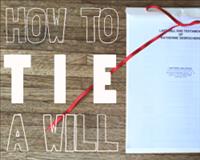
If you’ve never heard of the process of “tying a Will”, you are definitely not alone. Tying a Will is an ancient method of finishing off a legal document that was once widely used, though is rather rare today. But that rarity and time-honored sense of the ceremonial is exactly what I love about this process, and why I have decided to introduce it as the finishing flourish to your estate plan: it’s my way of showing a nod of respect to this important step in your life.
As the name suggests, in this procedure the Will is literally "tied" together with ribbon, just after the signing and notarization. The ends of the ribbon are then sealed just below the signature. In addition to providing a special look and sense of formality, tying and sealing the Will functions as an extra security measure that prevents anyone from removing pages, or otherwise tampering with the finished Will.
This method has been used since ancient times, and can be found as one of the earliest uses of personal and governmental wax seals. Tying and sealing was the first and primary method of document security and can be observed as an enduring tradition in just about every major civilization on the globe.
The imprint of a seal serves two major purposes of security. The first is that a seal imprint indicates that the creator of the document was present at the time of the document’s tying and sealing. The second is that a seal is meant to be applied in such a way as to indicate tampering if broken. That is why seals were (and still are) applied to the outsides of envelopes: if the seal is broken, you know that someone has been reading your mail. And in the case of our tied and sealed Wills, if the seal is broken, you know that someone has tampered with the ribbons which tie your Will together.
Seals are highly personal; on par with an individual’s signature. The use of a seal is by no means extinct either. Although the use of wax and classic intaglio seals has largely given way to ink stamps or foil stickers, seals are still widely used as a method of authentication for documents (particularly legal ones). In many parts of the world, including America, Central/Eastern Europe, and East Asia, a signature alone is often considered insufficient to validate a business or legal document.
Given the historical importance and ceremonial beauty, I can see no better way to salute your estate planning efforts than by tying and sealing your Will; a tradition that stands the test of time.
Interested in learning to tie a Will yourself? Here are some simple step-by-step instructions for the process. And of course, if you are interested in creating your own Will, please feel free to make an appointment for your free consultation today. Just click the link on the left, or call the number above.
Happy tying!